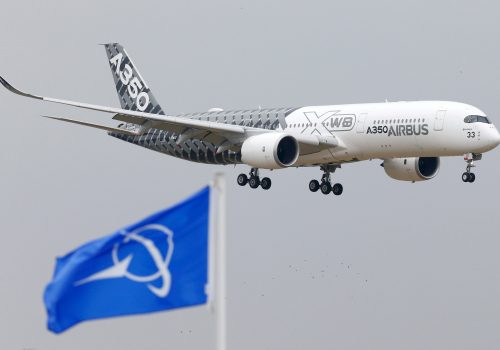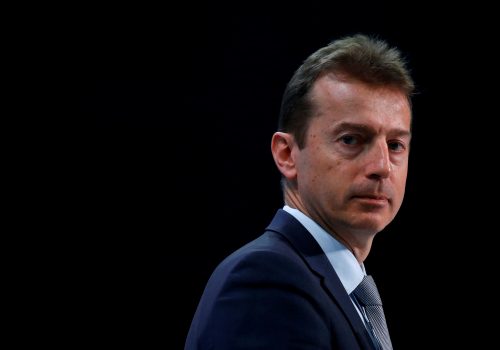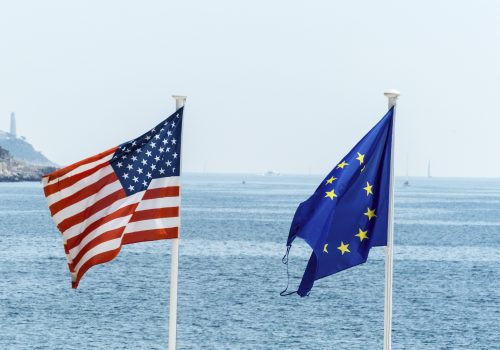FAST THINKING: An Airbus-Boeing deal, seventeen years in the making
JUST IN
It’s a trade spat so old that it started last cicada cycle. After seventeen long years—including dueling legal cases at the World Trade Organization and sprawling retaliatory tariffs on everything from French wine to American self-propelled shovel loaders—President Joe Biden unveiled on Tuesday that the United States had reached a deal with the European Union to resolve the dispute between Airbus and Boeing over aircraft subsidies. The agreement, announced just ahead of Biden’s first US-EU Summit, will suspend billions of dollars’ worth of threatened tariffs for five years. So why, after nearly two decades of wrangling, did this happen now? And what’s coming next in the dispute and transatlantic relations more broadly? Our experts are here with the 30,000-foot view and the close read of the accord.
TODAY’S EXPERT REACTION COURTESY OF
- Julia Friedlander (@jfriedlanderdc): C. Boyden Gray senior fellow, deputy director of the GeoEconomics Center, and former National Security Council director
- Marc Busch (@tradecraft_pod): Nonresident senior fellow at the Scowcroft Center for Strategy and Security and professor of international business diplomacy at Georgetown University
Prepare for landing
- The Airbus-Boeing dispute has been “the paradigm of WTO dead ends,” Julia tells us—a case “where the moral lines aren’t easy to draw” and “both sides are probably equally as right as they are wrong.”
- And what finally provided the escape from that dead end wasn’t even a party to the dispute, Marc argues. Instead, it was a common rival: “Washington and Brussels need each other to deal with China, particularly at the WTO, and neither derived any meaningful leverage from wielding their retaliatory tariffs.”
The deal is in the details
- Is this truly a deal, Marc asks, or is it “a cessation of hostilities owing to the fact that WTO-authorized retaliation got out of control?” He’s betting on the latter: “The rub is that both sides feel they, but not the other, has long been in compliance with the WTO rulings against them.”
- Marc notes, for example, that aircraft subsidies will be capped as part of the agreement. But what, he wonders, is the definition of subsidies? Does it apply both to “direct launch aid (what Airbus gets) and indirect government R&D subsidies (what Boeing gets)?”
- For the moment, “the many US and EU industries hurt as collateral damage in this trade war,” rather than “the minutiae of subsidies,” captured the attention of politicians across the Atlantic. “But don’t be mistaken, the key to peace in our time is the minutiae,” he advises.
Over the horizon
- This “interim resolution” is “still progress,” Julia notes, but keep in mind that it is ultimately up to Boeing and Airbus—not Biden and European Commission President Ursula von der Leyen—“to agree to the terms of a settlement. And that means two things: time and lawyers.”
- Here’s what’s coming, according to Julia: “Given the five-year ‘ceasefire,’ expect an extension of the negotiations, followed by an extended suspension of retaliatory measures. It also means that Brussels has to mollify Germany, France, and Spain, where Airbus aircraft are made, and Washington, DC, will have words with Washington state.”
- “On trade, we have arguably been distracted by the past,” Julia adds, rather than recognizing that issues such as “data privacy and climate change are the future of the transatlantic relationship.”
- In that sense, she notes, “announcing a resolution on Boeing-Airbus is an opening salvo to move on from disputes over heavy industry—an increasingly anachronistic pastime—and onto the issues that will remake the global economy and the institutions that govern it.”
Further reading
Mon, Jun 14, 2021
US-EU Summit may end aircraft trade row, but it needs to fly higher to succeed
New Atlanticist By Barbara C. Matthews
If policymakers merely deliver movement regarding tariffs on selected physical items, they will have missed an opportunity to craft the foundations for a meaningful transatlantic relationship.
Thu, May 6, 2021
Airbus CEO talks disputes with Boeing, a new Chinese rival, and hydrogen planes
Transcript By
Guillaume Faury joined the Atlantic Council's EU-US Future Forum to discuss the future of the airline industry, as it emerges from the pandemic.
Fri, Feb 12, 2021
Time for transatlantic trade to take off
EconoGraphics By Ole Moehr
Trade tariffs continue to pose a threat to a transatlantic economy weakened by COVID-19, but there may now be some light at the end of the tunnel. Keen to rebuild transatlantic ties, Washington and Brussels must walk the talk to reach an agreement on aircraft subsidies and move the US-EU trade agenda forward.
Image: A Japan Airlines Boeing 767-300ER plane takes off as a Philippine Airlines Airbus A330-300 plane taxis on the runway of the Ninoy Aquino International Airport in Manila, Philippines on January 11, 2018. Photo via REUTERS/Romeo Ranoco.


